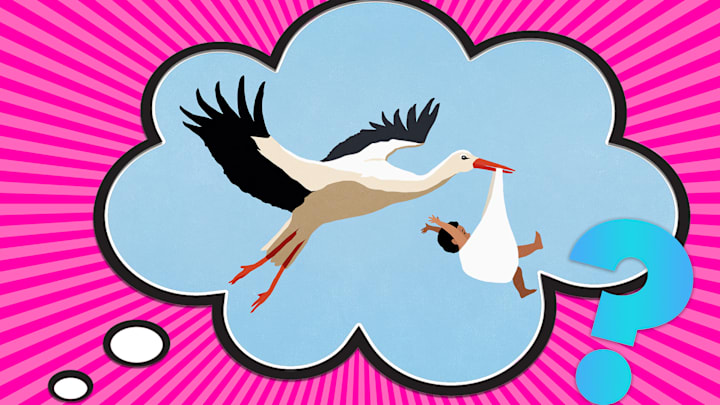There comes a point in every child’s life when they ask where babies come from, and some parents—not wanting to explain the details of reproduction just yet—turn to the story of storks. Even if adults are up-front about the facts of life, kids are often exposed to the myth of storks delivering babies via media. Disney’s 1941 animated classic Dumbo, which starts with a scene of the long-legged birds dropping bundled-up babies to their circus animal parents, is the most famous example. But this myth predates Disney by at least a few hundred years.
The Less Likely Mythological Origin
The roots of this feathery folk story are sometimes traced back to Greek mythology, specifically the tale of the Pygmy queen Gerana drawing the eye—and ire—of Hera, the vengeful queen of the gods. Gerana boasted about her beauty and was deified by her people, so Hera punished her by turning her into a stork. Gerana, not willing to leave her young son behind, either flew around to stay close to him, or, as some later versions tell it, snatched him up in her beak.

There’s one issue with this myth being the predecessor of the story about storks delivering babies, though: Gerana was actually transformed into a crane. This mix-up likely occurred because, in the words of Rachel Warren Chadd, co-author of Birds: Myth, Lore and Legend, “it can be difficult to verify that one species is associated with an ancient myth as, for instance, storks, cranes and herons were often confused.”
Bird species being mistaken for one another is also a problem with the other suggested forerunners of the storks-bringing-babies tale. Another commonly cited source of inspiration is the deity Bennu’s creation of the world—which can be thought of as a birth—in Egyptian mythology; Bennu is sometimes said to be represented by a stork, but he’s actually portrayed as a heron. An example from medieval Catholicism depicts the pelican as a symbol of parental self-sacrifice, with images showing the bird piercing its own breast to feed its chicks. Although it’s unlikely that these myths are the direct ancestors of the stork delivery story we tell today, they may have sown the seeds of birds and babies being linked.
The More Likely Historical Origin
Rather than being traced back to older avian myths, historians think the story about storks bringing babies actually took off thanks to the migration of real-life storks in northern Europe, particularly in Germany and Norway, during the medieval era (and possibly even earlier). Couples would often get married around the summer solstice because of the season’s association with fertility. Nine months later, many of these newlyweds would be welcoming newborns into the world, which just so happened to coincide with storks migrating back to Europe in the spring after having spent winter in Africa. At some point, the folklore that the returning storks were bringing the babies began circulating.
While many birds migrate back to northern Europe at that time of year, storks stand out for a few reasons. “The birds are big and white—linked to purity—and their nests are large, prominent and close to where people live. So, their good parenting behavior is highly evident,” Warren Chadd explained to Live Science. Other elements were added to the myth over time. In Germany, for instance, storks would supposedly collect the souls of unborn babies from caves, marshes, and ponds. Kids wanting a new sibling would try to tempt the birds to their house with songs and sweets. The baby-bringing stork myth also independently developed in America, with the Sioux version being about wood storks, rather than white storks.

The story then got a boost in popularity thanks to Hans Christian Andersen’s 1839 short story “The Storks” (Storkene in the original Danish). In Andersen’s version, the birds take unborn babies from a pond and deliver them to their parents, but the family of a naughty child who bullied a stork is punished with the delivery of a dead baby. English Literature academic Paul Quinn explains that the story—with its added moral lesson—was part of the new “ ‘infantilizing’ fairy tales” literary tradition for children, which was “frequently didactic and religious in intent.”
While it’s no longer as common to tell curious kids the avian tale educationally, it is still pervasive culturally. In addition to showing up in media and on cards, clothing, and gifts for new babies, the myth has even infiltrated the medical world: a birthmark on the back of a baby’s head or neck often being called a “stork bite.”
Discover More Stories About Folklore:
